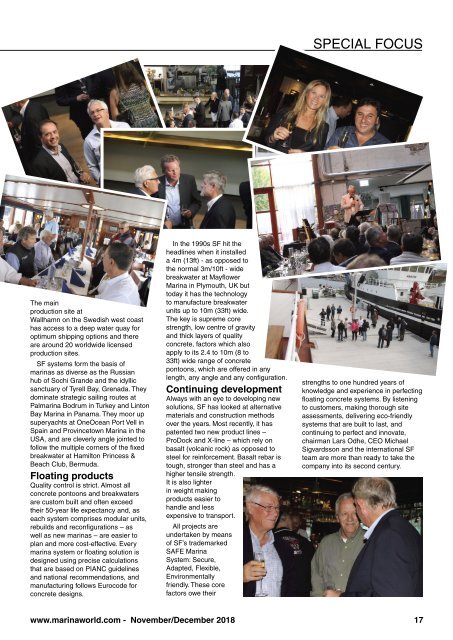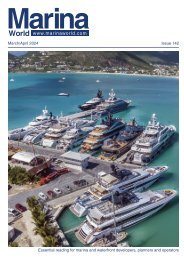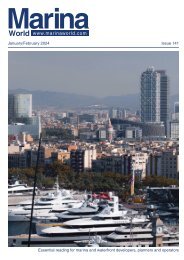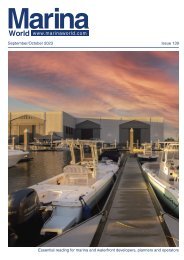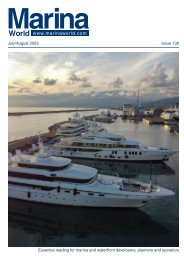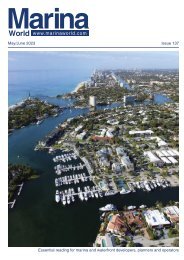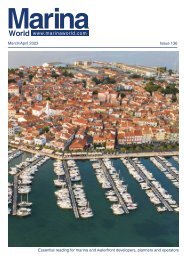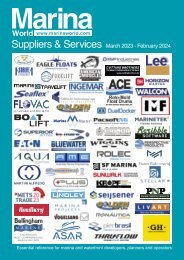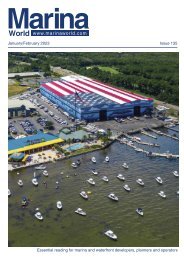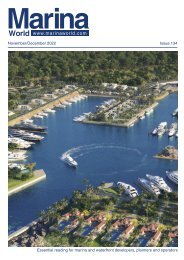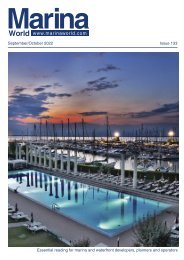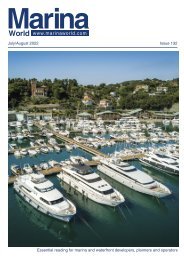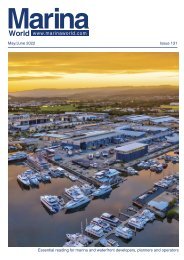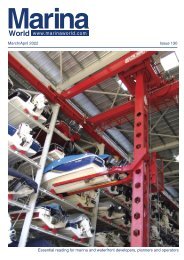You also want an ePaper? Increase the reach of your titles
YUMPU automatically turns print PDFs into web optimized ePapers that Google loves.
SPECIAL FOCUS<br />
The main<br />
production site at<br />
Wallhamn on the Swedish west coast<br />
has access to a deep water quay for<br />
optimum shipping options and there<br />
are around 20 worldwide licensed<br />
production sites.<br />
SF systems form the basis of<br />
marinas as diverse as the Russian<br />
hub of Sochi Grande and the idyllic<br />
sanctuary of Tyrell Bay, Grenada. They<br />
dominate strategic sailing routes at<br />
Palmarina Bodrum in Turkey and Linton<br />
Bay <strong>Marina</strong> in Panama. They moor up<br />
superyachts at OneOcean Port Vell in<br />
Spain and Provincetown <strong>Marina</strong> in the<br />
USA, and are cleverly angle jointed to<br />
follow the multiple corners of the fixed<br />
breakwater at Hamilton Princess &<br />
Beach Club, Bermuda.<br />
Floating products<br />
Quality control is strict. Almost all<br />
concrete pontoons and breakwaters<br />
are custom built and often exceed<br />
their 50-year life expectancy and, as<br />
each system comprises modular units,<br />
rebuilds and reconfigurations – as<br />
well as new marinas – are easier to<br />
plan and more cost-effective. Every<br />
marina system or floating solution is<br />
designed using precise calculations<br />
that are based on PIANC guidelines<br />
and national recommendations, and<br />
manufacturing follows Eurocode for<br />
concrete designs.<br />
In the 1990s SF hit the<br />
headlines when it installed<br />
a 4m (13ft) - as opposed to<br />
the normal 3m/10ft - wide<br />
breakwater at Mayflower<br />
<strong>Marina</strong> in Plymouth, UK but<br />
today it has the technology<br />
to manufacture breakwater<br />
units up to 10m (33ft) wide.<br />
The key is supreme core<br />
strength, low centre of gravity<br />
and thick layers of quality<br />
concrete, factors which also<br />
apply to its 2.4 to 10m (8 to<br />
33ft) wide range of concrete<br />
pontoons, which are offered in any<br />
length, any angle and any configuration.<br />
Continuing development<br />
Always with an eye to developing new<br />
solutions, SF has looked at alternative<br />
materials and construction methods<br />
over the years. Most recently, it has<br />
patented two new product lines –<br />
ProDock and X-line – which rely on<br />
basalt (volcanic rock) as opposed to<br />
steel for reinforcement. Basalt rebar is<br />
tough, stronger than steel and has a<br />
higher tensile strength.<br />
It is also lighter<br />
in weight making<br />
products easier to<br />
handle and less<br />
expensive to transport.<br />
All projects are<br />
undertaken by means<br />
of SF’s trademarked<br />
SAFE <strong>Marina</strong><br />
System: Secure,<br />
Adapted, Flexible,<br />
Environmentally<br />
friendly. These core<br />
factors owe their<br />
strengths to one hundred years of<br />
knowledge and experience in perfecting<br />
floating concrete systems. By listening<br />
to customers, making thorough site<br />
assessments, delivering eco-friendly<br />
systems that are built to last, and<br />
continuing to perfect and innovate,<br />
chairman Lars Odhe, CEO Michael<br />
Sigvardsson and the international SF<br />
team are more than ready to take the<br />
company into its second century.<br />
www.marinaworld.com - <strong>November</strong>/<strong>December</strong> <strong>2018</strong> 17


